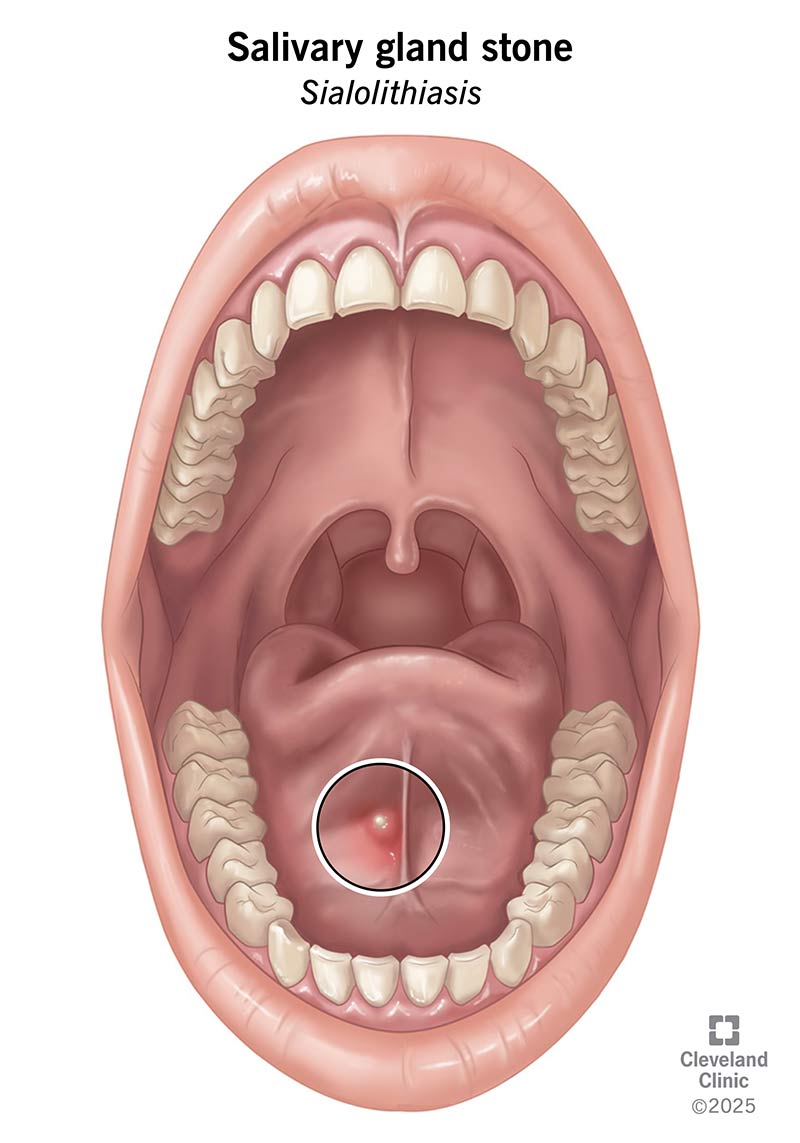Salivary stones, also called sialolithiasis or salivary gland stones, typically develop in your submandibular salivary gland. Common symptoms are pain when you eat, swelling in your neck and face, and difficulty swallowing. Treatment to remove the stone ranges from home care to surgery.
Advertisement
Cleveland Clinic is a non-profit academic medical center. Advertising on our site helps support our mission. We do not endorse non-Cleveland Clinic products or services. Policy

Salivary gland stones are hardened mineral deposits that develop in your salivary glands. The condition is also known as salivary stones or sialolithiasis. Your salivary glands make saliva. If you have a salivary stone, the stone traps saliva in your gland to cause swelling and pain.
Advertisement
Cleveland Clinic is a non-profit academic medical center. Advertising on our site helps support our mission. We do not endorse non-Cleveland Clinic products or services. Policy
Sialolithiasis can affect any salivary gland. But nearly all cases of salivary stones affect your submandibular gland. This gland is below your jaw, at the very back of your mouth.
Some salivary stones are tiny — about the size of a sharp pencil point. They may not cause symptoms. But a large (pea-size) stone can cause sudden, intense pain when you eat. Other symptoms include:
Anyone can get a salivary stone. But the condition is most common in males ages 30 to 60. Several things may cause the condition, including:
Some people develop salivary gland stones even when there isn’t a clear cause.
Your salivary gland may become infected if saliva builds up behind a salivary stone.
A healthcare provider will ask about your symptoms and your medical history. They’ll check for lumps in your jaw and neck. They may do tests, including:
Treatment involves removing the stone. Your provider may recommend that you try self-care first. For example:
Advertisement
If home care doesn’t work, your provider may push on your gland with a special tool. The pressure may loosen the stone so it moves out of your gland.
Sometimes, surgery is the only way to treat a large salivary gland stone. Your provider may do endoscopic surgery or open surgery:
You should talk to a healthcare provider if you have sudden, frequent and intense pain, pressure or swelling when you eat food. A salivary stone may be the cause.
If you have a blocked salivary gland, you may experience pain or swelling around your salivary ducts during mealtimes. Usually, these symptoms last about one to two hours, then diminish until your next meal. Removing the stone usually cures the condition. But you may develop a new stone. Talk to your healthcare provider if your symptoms come back.
No, they’re different conditions. The difference is that they build upon your tonsils. Tonsil stones tend to be soft.
Your salivary glands make spit that helps you chew food. A salivary gland stone can make chewing a painful chore. This condition isn’t serious. But without treatment, you may have an infection in your salivary gland.
Fortunately, self-care steps usually solve the problem. In some cases, you may need medical treatment. Talk to a healthcare provider if you think you may have a salivary stone. If you do, your provider will recommend the treatment that’s right for your situation.
Advertisement
Cleveland Clinic’s primary care providers offer lifelong medical care. From sinus infections and high blood pressure to preventive screening, we’re here for you.

Last reviewed on 12/15/2025.
Learn more about the Health Library and our editorial process.